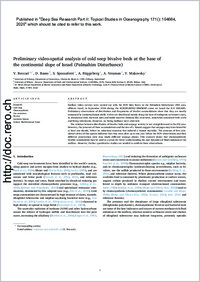Preliminary video-spatial analysis of cold seep bivalve beds at the base of the continental slope of Israel (Palmahim Disturbance)
- Beccari, Valentina University of Fribourg, Department of Geosciences, Chemin du Musée 6, 1700, Fribourg, Switzerland
- Basso, D. University of Milano - Bicocca, Department of Earth and Environmental Sciences, (CoNISMa, ULR), Piazza della Scienza 4, 20126, Milano, Italy
- Spezzaferri, Silvia University of Fribourg, Department of Geosciences, Chemin du Musée 6, 1700, Fribourg, Switzerland
- Rüggeberg, Andres University of Fribourg, Department of Geosciences, Chemin du Musée 6, 1700, Fribourg, Switzerland
- Neuman, A. Dr. Moses Strauss Department of Marine Geosciences and Hatter Department of Marine Technology, Leon H. Charney School of Marine Sciences (CSMS), University of Haifa, Haifa, 31905, Israel
- Makovsky, Y. Dr. Moses Strauss Department of Marine Geosciences and Hatter Department of Marine Technology, Leon H. Charney School of Marine Sciences (CSMS), University of Haifa, Haifa, 31905, Israel
-
01.01.2020
Published in:
- Deep Sea Research Part II: Topical Studies in Oceanography. - 2020, vol. 171, p. 104664
English
Seafloor video surveys were carried out with the ROV Max Rover in the Palmahim Disturbance (PD) area, offshore Israel, in September 2016 during the EUROFLEETS2 SEMSEEP cruise on board the R/V AEGAEO. Preliminary observations of distribution and frequencies of bivalve accumulations show that they are mostly composed by Lucinoma kazani shells. Valves are distributed mainly along the base of authigenic carbonate crusts, in association with bacterial mats and inside inactive chimney-like structures, sometimes associated with crabs and living tubeworms. However, no living molluscs were observed.The relation between distribution of bivalve beds and seepage activity is not straightforward in the PD area. However, the presence of these accumulations and the size of L. kazani, suggest that seepages may have lasted for at least one decade, before its reduction/cessation that induced L. kazani mortality. The presence of few articulated valves of this species indicates that they were alive up to one year before the ROV observations and their different preservation state may imply different seepage phases. This research shows that chemosymbiotic benthic communities may be used as a proxy for better understanding the past dynamics of fluid emissions at the seafloor. However, further quantitative studies are needed to confirm these observations.
- Faculty
- Faculté des sciences et de médecine
- Department
- Département de Géosciences
- Language
-
- English
- Classification
- Hydrology
- License
-
License undefined
- Identifiers
-
- RERO DOC 328442
- DOI 10.1016/j.dsr2.2019.104664
- Persistent URL
- https://folia.unifr.ch/unifr/documents/308551
Other files
Statistics
Document views: 167
File downloads:
- pdf: 369
- Supplementary material: 68

